How to Save on Cruises: Tips for Smart Travelers

Saving money on cruises sounds impossible with all the hidden fees, fluctuating ticket prices, and endless package options. Yet, some travelers have cracked the code and now pay up to 40 percent less than the average cruiser. Most people think they need deep pockets or industry connections to score these deals but the real secret has nothing to do with luck and everything to do with simple, strategic moves anyone can use.
Table of Contents
- Step 1: Research And Compare Cruise Options
- Step 2: Choose The Right Time To Book Your Cruise
- Step 3: Sign Up For Price Alerts And Deals
- Step 4: Consider Alternative Departure Ports
- Step 5: Take Advantage Of Onboard Discounts And Packages
Quick Summary
| Key Point | Explanation |
|---|---|
| 1. Conduct thorough cruise research | Explore multiple cruise lines and compare pricing to find the best deals and tailored experiences for your budget. |
| 2. Book early or last-minute | Timing affects prices; book 6-12 months in advance for early deals or consider last-minute discounts for spontaneous plans. |
| 3. Use price alerts effectively | Sign up for notifications on fare drops and promotions to save 15-25% on your bookings through targeted monitoring. |
| 4. Consider alternative departure ports | Expanding your options can yield savings; different ports may offer lower fares and better overall travel costs. |
| 5. Leverage onboard packages and discounts | Take advantage of pre-purchased deals to enhance your cruise experience while saving up to 40% on additional expenses. |
Step 1: Research and Compare Cruise Options
Starting your cruise savings journey begins with strategic research and smart comparison techniques. Understanding how to save on cruises requires a methodical approach that transforms potential travel expenses into affordable adventures. Comprehensive cruise research is your foundational strategy for uncovering the best deals and experiences tailored to your budget and preferences.
Begin by exploring multiple cruise lines and their diverse offerings. Each cruise line presents unique pricing structures, destination packages, and seasonal promotions that can significantly impact your total travel costs. Utilize digital platforms like our cruise booking tips guide to understand the nuanced pricing landscape. Focus on comparing base fares, included amenities, and potential additional expenses that might surprise budget-conscious travelers.
Digital tools and comparison websites become your most valuable allies in this research phase. Websites specializing in cruise aggregation allow you to view multiple itineraries, prices, and sailings simultaneously. Look beyond the initial ticket price and examine what’s included: some cruise lines offer packages with meals, entertainment, and basic beverages, while others charge separately for these services. Tracking prices across different platforms can reveal significant savings opportunities.
Consider the timing of your cruise as a critical factor in your research strategy. Prices fluctuate dramatically based on seasonality, destination popularity, and cruise line promotional periods. Shoulder seasons typically offer more affordable rates with similar experience quality. For instance, Caribbean cruises during early fall or Mediterranean voyages in late spring can provide exceptional value compared to peak summer months.
According to a comprehensive travel industry analysis, travelers who invest time in thorough research can save up to 40% on their cruise bookings. This statistic underscores the importance of a patient, methodical approach to cruise selection. Take screenshots, create comparison spreadsheets, and track price changes over several weeks to identify the most attractive deals.
Use this checklist table to guide your cruise research and price alert process, so you can confidently verify key savings strategies step by step.
| Step | Actions to Verify Completion | Notes |
|---|---|---|
| Compare multiple cruise lines | Recorded prices and amenities for each line | Use comparison websites and spreadsheets |
| Track prices over several weeks | Noted price changes and trends | Screenshots or logs recommended |
| Set up price alerts on platforms | Registered and personalized notification setup | Include preferred dates and destinations |
| Monitor alert notifications | Checked at least twice weekly | Ready to act quickly if deals appear |
| Review total trip costs | Calculated fares plus transportation/fees | Avoid surprise expenses |
| Read traveler reviews and experiences | Reviewed recent ship feedback | Helps with final value assessment |
Your research should also extend beyond pricing. Read traveler reviews, examine ship amenities, and consider your personal preferences for destinations, onboard experiences, and travel style. A slightly more expensive cruise might offer better value if it aligns more closely with your ideal vacation experience.
Step 2: Choose the Right Time to Book Your Cruise
Selecting the optimal booking window can dramatically impact your cruise savings strategy. Timing is everything when hunting for the best cruise deals, and understanding the nuanced rhythm of cruise pricing can help you secure substantial discounts. Your goal is to strike a precise balance between early planning and strategic waiting.
Most experienced travelers recommend booking cruises either very early or very close to the sailing date. Early bird bookings typically occur 6 to 12 months before departure, offering significant advantages. Cruise lines often provide attractive early booking incentives like discounted fares, cabin upgrades, onboard credits, and flexible cancellation policies. These promotions reward travelers who plan ahead and commit to their travel dates well in advance. Explore our comprehensive planning guide to understand these strategic booking windows.
Conversely, last-minute bookings can also yield unexpected savings for flexible travelers. Cruise lines occasionally need to fill remaining cabins close to sailing dates and may offer steep discounts to ensure maximum occupancy. These eleventh-hour deals work best for spontaneous travelers with adaptable schedules who can make quick travel arrangements. However, this approach carries risks such as limited cabin selections and potentially higher airfare costs.
Seasonal variations play a crucial role in cruise pricing dynamics. Peak travel seasons like summer and holiday periods typically command premium prices. Shoulder seasons frequently present more budget-friendly options with similar experience quality. Caribbean cruises during early fall or Mediterranean voyages in late spring can offer exceptional value compared to peak months. Understanding these seasonal price fluctuations allows you to optimize your booking strategy.
According to a comprehensive cruise industry analysis, travelers who book between 3 to 6 months in advance often find the most balanced combination of price and availability. This timeframe allows you to capitalize on early booking discounts while maintaining flexibility.
 Additionally, consider monitoring price drops and being prepared to rebook if significant savings emerge after your initial reservation.
Additionally, consider monitoring price drops and being prepared to rebook if significant savings emerge after your initial reservation.
Verify your booking strategy by tracking prices across multiple platforms, setting price alerts, and remaining flexible with your travel dates. Success means securing a cruise that meets your budget and experience expectations while minimizing financial stress.
Below is a comparison table summarizing different cruise booking timing strategies, helping you understand when to book for optimal savings based on flexibility and risk level.
| Booking Timing | Description | Potential Savings | Best For | Considerations |
|---|---|---|---|---|
| Early Bird (6-12 mo) | Book well in advance to secure early deals and perks | Up to 20% | Planners | More cabin choices, promotional offers |
| Last-Minute | Reserve close to sail date for occupancy discounts | Up to 30% | Flexible travelers | Fewer cabin options, higher airfare possible |
| Shoulder Season | Book during less popular times | 10-20% | Value seekers | Fewer crowds, similar experience to peak season |
| Peak Season | High demand periods, limited deal availability | Minimal | School/family schedules | Premium pricing, book early to secure spots |
| 3-6 Months in Advance | Balance between price and availability | Up to 15% | Most travelers | Good mix of savings and cruise options |
Step 3: Sign Up for Price Alerts and Deals
Navigating the complex world of cruise pricing requires strategic digital tools and proactive monitoring. Price alerts transform your savings strategy by providing real-time updates on fare fluctuations, special promotions, and unexpected discounts that could significantly reduce your travel expenses. This step is about creating a sophisticated tracking system that works continuously in your favor.
Start by creating accounts on multiple cruise booking platforms and travel websites. Explore our cruise booking tips to understand the most effective platforms for price tracking. Each website offers unique alert systems that notify you instantly when prices drop or promotional packages become available. Email and mobile notifications are your primary intelligence gathering tools in this savings mission.
Diversify your alert sources beyond traditional cruise websites. Travel aggregator platforms, credit card reward portals, and specialized cruise deal websites often provide complementary pricing information. Some platforms offer comprehensive tracking that monitors not just base fares but also additional perks like onboard credits, upgraded cabin options, and bundled package deals. This multi-channel approach increases your chances of discovering exceptional savings opportunities.
Personalize your alert parameters to match your specific travel preferences. Specify exact destinations, preferred cruise lines, travel dates, and budget ranges to receive hyper-relevant notifications. Advanced tracking systems can filter results based on cabin types, itinerary specifics, and even specific ship preferences. The more precise your settings, the more targeted and useful your price alerts become.
According to travel industry research, travelers who actively use price alert systems save an average of 15-25% on their cruise bookings. These savings emerge from a combination of strategic timing, persistent monitoring, and willingness to act quickly when exceptional deals appear. Create price alert accounts across multiple platforms to maximize your chances of discovering hidden discounts.
Successful price alert management requires consistent engagement. Check your notifications regularly, be prepared to book quickly when outstanding deals emerge, and maintain flexibility in your travel planning. Your goal is to transform passive booking into an active, intelligence-driven savings strategy that consistently uncovers the best possible cruise prices.
Step 4: Consider Alternative Departure Ports
Expanding your cruise search beyond traditional departure cities can unlock substantial savings and unexpected travel opportunities. Flexibility with departure ports is a powerful strategy for budget-conscious travelers seeking to optimize their cruise expenses. By broadening your geographic considerations, you transform potential limitations into strategic advantages.
Begin by mapping out all feasible departure ports within a reasonable driving or travel distance. Major metropolitan areas and coastal regions often host multiple cruise terminals with varying pricing structures. Explore our comprehensive planning resources to understand the nuanced differences between regional cruise departure options. Consider factors like transportation costs, parking fees, and regional travel expenses when evaluating alternative ports.
Transportation logistics become a critical component of your overall cruise budget. Calculate the total cost of reaching different departure ports, including fuel expenses, potential overnight stays, parking fees, and alternative transportation methods like shuttles or public transit. Sometimes, a slightly more distant port with significantly lower cruise fares can result in substantial overall savings. Factor in the time and effort required to reach each potential departure location.
Regional cruise markets exhibit distinct pricing dynamics. Ports in different states or proximity to major metropolitan areas might offer dramatically different fare structures for identical itineraries. Southern ports like Miami and Port Canaveral frequently feature more competitive pricing compared to less saturated markets. West Coast departure points can present unique opportunities for Pacific cruises, while Gulf Coast ports might offer more economical Caribbean voyage options.
According to a comprehensive travel industry analysis, travelers who explore multiple departure ports can save up to 30% on their total cruise expenses. These savings emerge from a combination of lower base fares, reduced transportation costs, and regional promotional variations. Some cruise lines even offer special incentives for less conventional departure locations to attract more diverse travelers.
Verify your alternative port strategy by creating detailed spreadsheets comparing total trip costs, including cruise fares, transportation expenses, and additional travel requirements. Success means identifying a departure port that minimizes your overall travel expenditure while maintaining your desired cruise experience. Remain open-minded and calculate the complete financial picture before making your final decision.

Step 5: Take Advantage of Onboard Discounts and Packages
Maximizing your cruise savings extends far beyond the initial booking price. Onboard packages and strategic discounts can transform your cruise experience while protecting your travel budget. Understanding how to navigate these opportunities requires a proactive and informed approach to cruise amenities and additional services.
Explore our cruise education resources to gain deeper insights into the nuanced world of cruise packages. Many travelers overlook the significant savings potential embedded in pre-purchased onboard packages. Beverage packages, dining upgrades, internet plans, and entertainment bundles can offer substantial discounts when acquired before boarding. Advance planning is your primary weapon in minimizing onboard expenses.
Pre-cruise purchasing strategies can yield impressive financial benefits. Cruise lines frequently offer substantial discounts on packages bought online before departure, sometimes reaching 20-30% off onboard prices. Wi-Fi packages, specialty dining experiences, and drink plans become dramatically more affordable when reserved in advance. Create a comprehensive budget that includes these potential add-ons, allowing you to lock in savings before setting sail.
Leverage loyalty programs and credit card partnerships as additional savings mechanisms. Many cruise lines offer tiered membership programs that provide incremental benefits, including discounted packages, priority booking, and exclusive onboard credits. Credit cards affiliated with specific cruise lines can generate significant value through accumulated points, complimentary upgrades, and specialized package deals. Research these opportunities thoroughly to maximize your potential savings.
According to a comprehensive cruise industry analysis, savvy travelers can save up to 40% on total cruise expenses by strategically selecting and timing their onboard packages. This approach requires careful research, comparing package inclusions, and understanding the specific value propositions of different cruise lines. Some packages might include gratuities, entertainment access, or specialized dining experiences that provide exceptional value.
Verify your onboard package strategy by creating a detailed spreadsheet comparing different options, calculating potential savings, and tracking inclusions. Success means identifying packages that genuinely enhance your cruise experience while maintaining financial prudence. Pay attention to the fine print, understand cancellation policies, and remain flexible in your selections to optimize your overall cruise investment.
Ready to Unlock Effortless Cruise Savings?
Finding real cruise savings is tough when old websites overwhelm you with confusing deals and endless click-throughs. If you dream of finding the best sailing at the right price but feel lost comparing options and chasing last-minute discounts, you are not alone. The tips you read here—research, price alerts, and smart onboard choices—are only the start. At ChooseCruise, we turn these strategies into action with advanced technology and a truly personal approach.

ChooseCruise is built for travelers who want to take charge of their planning. Use our real-time price tracking to catch savings as soon as they appear. Experience instant AI-powered cruise recommendations designed for your travel style. Book with confidence through our interactive itineraries and seamless booking tools. The best deals are available now and prices can change fast. Start your smarter cruise journey today—visit ChooseCruise to compare, customize, and book your ideal trip in just minutes.
Frequently Asked Questions
How can I effectively research cruise options to save money?
Start by exploring multiple cruise lines, comparing pricing structures, included amenities, and any seasonal promotions. Using digital platforms that aggregate cruise options can help you identify the best deals tailored to your budget.
What is the best time to book a cruise for the best savings?
The ideal booking window is often 3 to 6 months in advance or very close to the sailing date. Early bookings usually offer discounts and perks, while last-minute deals can provide substantial savings for flexible travelers.
How do price alerts work for cruise bookings?
Price alerts can notify you of fare fluctuations and special promotions. By creating accounts on various booking platforms and setting personalized alert parameters, you can receive real-time updates on price drops related to your specific travel preferences.
What are the advantages of considering alternative departure ports for cruises?
Flexibility with departure ports can unlock significant savings, as different ports often have varying pricing structures. By evaluating transportation costs and total expenses, travelers may find that distant ports with lower cruise fares offer the most economical options.
Recommended
Related reading
7 Smart Ways to Save on Cruises for Modern Travelers
Discover 7 smart ways to save on cruises with easy, practical tips designed for today’s digital cruise travelers. Learn to maximize value and minimize costs.
Understanding Why Choose River Cruises for Travel Fun
Discover why choose river cruises as your next adventure. Explore their benefits, unique experiences, and how they enhance travel enjoyment.
Understanding the Best Cruise Lines for Beginners
Discover the best cruise lines for beginners, understanding what they offer and why they matter for first-time cruisers.